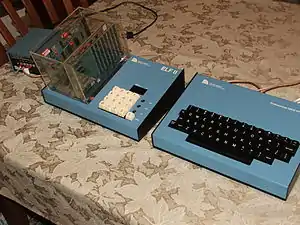ELF II
The Netronics ELF II was an early microcomputer trainer kit featuring the RCA 1802 microprocessor, 256 bytes of RAM, DMA-based bitmap graphics, hexadecimal keypad, two digit hexadecimal LED display, a single "Q" LED, and 5 expansion slots. The system was developed and sold by Netronics Research and Development Limited in New Milford, CT, USA.[1]
 | |
| Manufacturer | Netronics |
|---|---|
| Type | Hobbyist computer |
| Release date | 1978 |
| Operating system | Monitor ROM |
| CPU | 8 bit RCA 1802 |
| Memory | 256 Bytes to 64KB via 4KB or 16KB memory expansion cards |
| Storage | Cassette Tape |
| Display | none |
| Graphics | built in and rudimentary |
| Camera | none |
| Touchpad | HEX keypad |
| Power | external power supply |
Hardware
Available hardware accessories included:
- The "Giant Board" (ROM monitor, serial and parallel I/O, Cassette interface)
- 4KB and 16KB (static) RAM boards
- ASCII Keyboard
- Video display card (monochrome text)
- Low resolution color graphics board
- "Full BASIC" board with BASIC preloaded in ROM chips
- EPROM burner board
- External Power Supply
- Attractive, heavy duty metal cases for the CPU, keyboard, and power supply
Software
Available software included:
- 6800 Tiny BASIC (integer BASIC interpreter)[2]
- Text Editor
- Full BASIC (floating point BASIC interpreter using Reverse Polish Notation)
Notable Innovations
- Unlike similar "bare circuit card" trainer/experimenter computers of the day, the ELF II could be easily expanded thanks to its built-in bus.
- The video card is mounted underneath the keyboard inside the metal case. This allows it to be used as a standalone computer terminal if needed.
- The Elf II used a simple and low-cost math coprocessor. The "Full BASIC" ROM card contained an RPN calculator chip. As a result, floating point operations were an order of magnitude faster than what was possible in software. However, the BASIC syntax for math was non-standard as it used postfix RPN (see code example below). Historically, this was also the heyday of Hewlett Packard calculators, so it was a fair bet that any technically minded person willing to assemble a computer either already knew RPN or could easily learn it and adapt.
10 REM This program will print the number 30
20 A=10,B=20
30 C=A#B+
40 PRINT C
50 END
In the code above, the "#" symbol is equivalent to the "Enter" key on a RPN calculator.
The Name
The ELF part of the name came from an earlier machine called the "COSMAC ELF", published as a construction project in Popular Electronics magazine. Improvements on its predecessor included an etched PCB, a hexadecimal keypad instead of toggle switches for program entry, the CDP1861 Pixie-graphics chip, and the 5 slot 86-line bus for expansion cards.
See also
- COSMAC ELF
- RCA COSMAC VIP
- Quest SuperELF
- RCA 1802 microprocessor
- Early Microcomputers
- Competing 6502 microprocessor based trainers KIM-1 and Rockwell AIM-65
- 8080 Based machines: MITS Altair 8800 and IMSAI 8080
- RCA Studio II
References
- "Image of Mailing Box with Address Label". VCFED.org. Retrieved 27 June 2016.
- Pittman, Tom. "Tiny Basic Info". Itty Bitty Computers. Retrieved 4 August 2020.